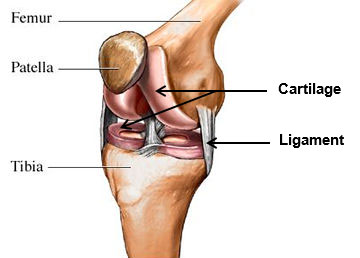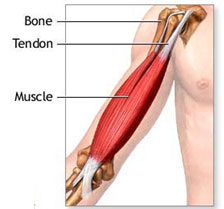
Source: Skeletal System, Wikimedia Commons
The skeletal and muscular systems work together to provide movement and support for the human body.

Source: Skeletal System, Wikimedia Commons
The main functions of the skeletal system are to provide structure and protection. The human skeleton is made up of bones and cartilage. There are 206 bones in the human body. Bones are primarily made up of calcium and phosphorus. Bones are made of living cells and can grow and repair themselves.

Source: Blood Cell Types, Algonquin College
Blood cells are produced inside the soft inner marrow of the bones.
A joint is the place where two bones come together. Some joints move and some do not. For example, the joints found in the skull do not move, the joints are held together by ligaments. Ligaments are made of connective tissue.
Cartilage, found at the end of the bones, helps reduce friction by keeping the bones from rubbing against each other. Cartilage can be found in other places in the body, such as the ear and the end of the nose. Cartilage is very different from bone; it is more flexible and does not contain blood vessels or minerals whereas bones do.
The image below shows the three bones that make up the knee as well as the cartilage that cushions the bones and ligaments that hold the bones together.

Source: The Knee, Health MD
The muscular system is responsible for movement. There are approximately 700 muscles that make up the muscular system. There are three types of muscles: cardiac, smooth, and skeletal.

Source: Three types of Muscles, National Library of Medicine
Smooth and cardiac muscle are called involuntary muscles because the human body cannot consciously control the movement of these muscles. Smooth muscles are found in the digestive organs, and blood vessels and cardiac muscle are found in the heart.

Source: Tendon, National Library of Medicine
Skeletal muscles are voluntary because the human body can consciously control the movement of these muscles. Skeletal muscles are attached to the skeleton with a tissue called a tendon.
The function of the integumentary system is protection. The integumentary system is made up of the skin, hair, and nails.
The skin is the largest organ in the body. The skin of an average size person weighs about ten pounds. The skin protects the body from chemicals, physical damage, UV light, and disease. The skin also prevents water loss. The skin also helps eliminate waste via sweat. The skin is made up of three layers.

Source: Human Hair, NPR
Humans have very little hair compared to other primates. The hair humans have serves very important functions. Hair protects the human body from damaging UV light and debris and other foreign objects. Hair also collects sweat and helps regulate body temperature. The image to the right was taken under a microscope. It shows a human hair emerging from the skin.

Source: Nails, Wise Geek
Nails are a type of modified skin. Nails protect the tips of the human body’s fingers and toes.